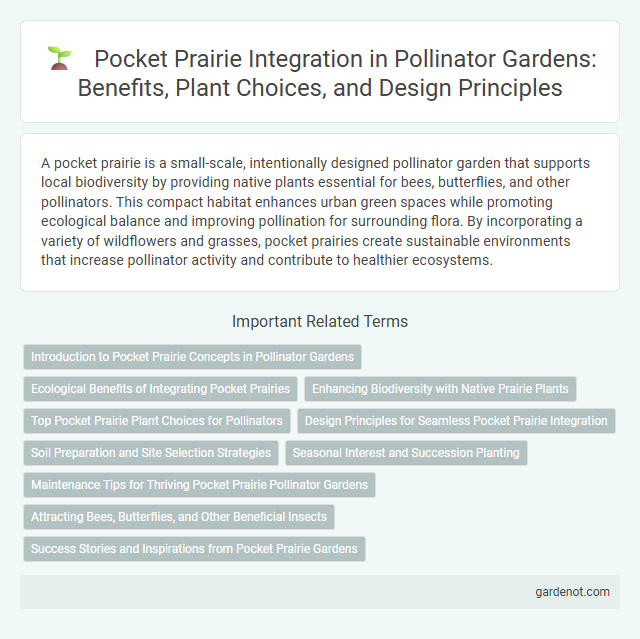A pocket prairie is a small-scale, intentionally designed pollinator garden that supports local biodiversity by providing native plants essential for bees, butterflies, and other pollinators. This compact habitat enhances urban green spaces while promoting ecological balance and improving pollination for surrounding flora. By incorporating a variety of wildflowers and grasses, pocket prairies create sustainable environments that increase pollinator activity and contribute to healthier ecosystems.
Introduction to Pocket Prairie Concepts in Pollinator Gardens
Pocket prairies are small, native plant habitats designed to support pollinators by providing essential food and shelter within urban or suburban spaces. These compact ecosystems utilize a mix of native grasses and wildflowers, creating an environmentally friendly habitat that enhances biodiversity and promotes pollination. Integrating pocket prairies into pollinator gardens contributes to the restoration of native plant species and supports populations of bees, butterflies, and other vital pollinators.
Ecological Benefits of Integrating Pocket Prairies
Pocket prairies enhance pollinator gardens by providing native wildflowers and grasses that support diverse pollinator species such as bees, butterflies, and hummingbirds. These small-scale prairies improve soil health through deep-rooted plants that promote aeration and nutrient cycling, reducing erosion and increasing groundwater infiltration. Integrating pocket prairies also boosts urban biodiversity, creating habitat corridors that connect fragmented green spaces and strengthen local ecosystems.
Enhancing Biodiversity with Native Prairie Plants
Pocket prairies enhance biodiversity by incorporating diverse native prairie plants that support local ecosystems and provide essential habitats for pollinators such as bees, butterflies, and birds. These small-scale restorations of native flora promote soil health, improve air quality, and increase the resilience of urban and suburban environments against invasive species. Planting native grasses, wildflowers, and legumes fosters a balanced ecosystem that sustains pollinator populations and encourages natural pest control.
Top Pocket Prairie Plant Choices for Pollinators
Top pocket prairie plant choices for pollinators include native wildflowers such as purple coneflower (Echinacea purpurea), black-eyed Susan (Rudbeckia hirta), and butterfly milkweed (Asclepias tuberosa), which provide essential nectar and pollen sources. Grasses like little bluestem (Schizachyrium scoparium) offer habitat structure and protection for pollinator species. Selecting a diverse mix of these plants ensures continuous bloom periods and supports a wide range of native bees, butterflies, and other beneficial insects in pocket prairie gardens.
Design Principles for Seamless Pocket Prairie Integration
Incorporate native plant species and layered vegetation structures to mimic natural prairie ecosystems, promoting biodiversity and supporting local pollinators effectively. Use site-specific design strategies, such as soil preparation and water management, to enhance plant survival and ecosystem resilience. Integrate pocket prairies in small urban spaces by balancing aesthetics with ecological function, ensuring seamless blending into existing garden landscapes.
Soil Preparation and Site Selection Strategies
Selecting a sunny, well-drained site with minimal foot traffic enhances pocket prairie success by promoting native pollinator plant growth. Soil preparation involves loosening compacted soil to improve aeration and mixing in organic matter such as compost to boost nutrient levels and moisture retention. Conducting soil tests guides amendments, ensuring the soil pH and fertility meet the requirements for diverse wildflower and grass species that attract and support pollinators.
Seasonal Interest and Succession Planting
Pocket prairies offer dynamic seasonal interest by showcasing a diverse range of native wildflowers and grasses that bloom in succession from spring to fall, ensuring continuous habitat and nectar sources for pollinators. Succession planting in pocket prairies enhances biodiversity by staggering flowering times, supporting a variety of pollinator species throughout the growing season. This approach maximizes ecological benefits and aesthetic appeal in pollinator gardens, promoting sustainable habitats for bees, butterflies, and other beneficial insects.
Maintenance Tips for Thriving Pocket Prairie Pollinator Gardens
Regularly monitor soil moisture to prevent drought stress while avoiding waterlogging, ensuring native prairie plants establish strong root systems. Implement seasonal mowing or controlled burns in late fall to suppress invasive weeds and promote native plant regeneration. Avoid chemical pesticides and fertilizers to create a healthy habitat for pollinators such as bees, butterflies, and hummingbirds thriving in pocket prairie gardens.
Attracting Bees, Butterflies, and Other Beneficial Insects
Pocket prairies create diverse habitats that attract bees, butterflies, and other beneficial insects by offering native wildflowers and grasses rich in nectar and pollen. These small-scale ecosystems support pollinator health and increase biodiversity by providing essential food sources and shelter throughout the growing season. Implementing pocket prairies in urban and suburban areas enhances ecological connectivity and promotes natural pest control.
Success Stories and Inspirations from Pocket Prairie Gardens
Pocket prairie gardens have transformed small urban spaces into vibrant ecosystems supporting diverse pollinators like bees, butterflies, and native birds. Success stories highlight increased local biodiversity, enhanced soil health, and community engagement in cities such as Minneapolis and Chicago, where residents report flourishing native wildflowers and thriving pollinator populations. These inspiring urban oases demonstrate how pocket prairies contribute significantly to habitat restoration and environmental sustainability in densely populated areas.
Pocket prairie Infographic

 gardenot.com
gardenot.com